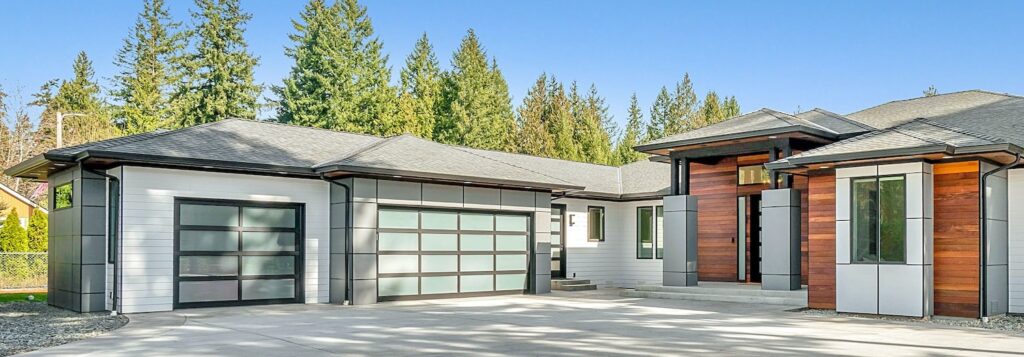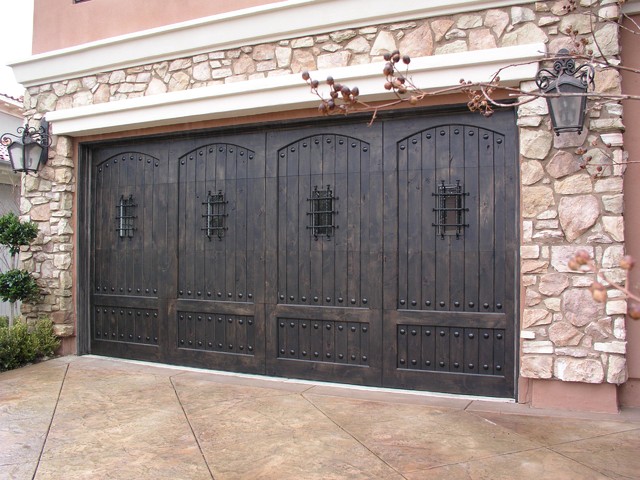Garage Doors: The Ultimate Guide
Welcome to our in-depth guide of garage doors! Here we discuss everything from the types, materials, and designs to maintenance tips and safety features. This article is your complete guide, providing you with the insights needed to make informed decisions about your garage door. So, if you’re thinking about getting a new garage door, want to try fixing it up yourself, or just need to keep the one you have in good shape, this guide has got you covered with all the information you’ll need.
Garage Door Types
There’s a variety of garage door types to choose from. Here’s a breakdown to help you understand your options:
Swinging Garage Doors: These doors operate like a standard door in your home, swinging open outward. Swinging garage doors are straightforward and has a simple mechanism but do require space in front of the garage to open fully.
Sliding Garage Doors: Similar to sliding patio doors, these garage doors slide to one side to open. Sliding garage doors are a good choice if you’re looking to save space or if you have a wide garage opening.
Bi-fold Garage Doors: These doors fold in the middle as they open, somewhat like an accordion. If you’re looking for something a bit different, bi-fold garage doors are a convenient option and can be a great space saver.
Double Garage Doors: Have wide entrances and designed for larger garages that can fit two vehicles side by side.
Manual Garage Doors: These doors are operated by hand, without the aid of an electric opener. They’re simpler and often more affordable but require manual effort to open and close.
Roll-up Garage Doors: Roll-up doors are made from horizontal slats that roll up above the garage opening. They’re commonly used in commercial settings but are also suitable for residential garages, especially where ceiling space is limited.
Side Garage Doors: Instead of opening upwards, these doors open to one side, similar to sliding doors but with a different mechanism. They’re a good solution for garages where traditional overhead doors might not be feasible.
Interior Garage Doors: These are used inside the garage to section off different areas or to provide a barrier between the garage and the living spaces of the home. They’re useful for climate control and noise reduction.
Read more about Garage Door Types >>
Garage Door Materials
The material of your garage door not only influences its appearance but also its functionality, durability, and how you will maintain it. Here’s a closer look at the most common used garage door materials:
Glass Garage Doors: These doors have a modern and sleek look that allows natural light to enter the garage. They are typically framed in aluminum for strength and durability. Glass doors can be insulated to improve energy efficiency but requires regular cleaning to maintain their clear appearance.

Fiberglass Garage Doors: Fiberglass doors are lightweight and resistant to denting, rusting, and warping. They can be designed to mimic the texture and appearance of wood without the maintenance that real wood requires. However, in extremely cold climates, fiberglass can become brittle and may crack.
Steel Garage Doors: Steel is one of the most popular materials for garage doors due to its strength, durability, and affordability. Steel doors can be insulated to improve thermal efficiency. They do, however, need to be monitored for rust, especially in coastal areas.
Aluminum Garage Doors: Aluminum doors are lightweight, rust-resistant, and suitable for large garage door openings. They are less prone to denting than fiberglass but can still be affected by impacts. Aluminum doors can also be insulated and come in various finishes.
Wooden Garage Doors: Wooden doors have a classic and natural look that are preferred by many. They can be custom-made in a variety of designs but need regular maintenance, like painting or staining, to protect against the elements and prevent warping or rotting.
Vinyl Garage Doors: Vinyl doors are known for their durability, resistance to dents, and minimal maintenance. They are ideal for homes in harsh weather conditions since they do not rust, fade, or crack. Vinyl doors can also be insulated.
Read about the top Garage Door Materials >>
Garage Door Designs
The design of your garage door significantly impacts the overall look of your home’s exterior. From traditional to contemporary, there are several designs to choose from:
Barn Garage Doors: Inspired by classic style of barns, these doors often feature crossbuck panels and can be made of wood or steel with a wood-look finish. They’re perfect for adding a country or farmhouse style to your home.
Carriage Garage Doors: Carriage-style doors date back to the days of horse-drawn carriages, with their distinctive look of swinging doors but with the modern convenience of rolling upwards. They often have decorative hardware, such as wrought-iron hinges or handles, to enhance the illusion of swing-out doors.
Rustic Garage Doors: Rustic doors are designed to look weathered or distressed that adds an earthy feel to your home. They are often made of natural wood, stone accents, or aged metalwork to make them a good fit for homes with a natural, outdoorsy design.

Read the most Stylish Garage Door Designs >>
Garage Door Maintenance
Regular garage door maintenance is important for its longevity, functionality, and safety. Here are some key aspects to focus on:
Garage Door Insulation: Adding insulation to your garage door can significantly improve energy efficiency. Insulation helps maintain temperature control which reduces the energy required to heat or cool your home. It also contributes to noise reduction.
Garage Door Weather Stripping: Weather stripping around the edges of your garage door is essential for keeping out wind, rain, and dirt. Over time, weather stripping can become worn or damaged that lead to drafts and water ingress. Regularly checking and replacing weather stripping as needed will help protect your garage and its contents from the elements.
Garage Door Lubricant: Proper lubrication of your garage door parts such as hinges, rollers, and tracks, is important for hassle-free and quiet operation. It can also extend the life of these components by reducing friction. Use a silicone-based lubricant designed for garage doors, and apply it every six months or as needed.
Garage Door Rust Prevention: If your garage door is made of steel or another metal, it’s susceptible to rust, especially in humid or coastal areas. Regularly inspect your door for signs of rust or corrosion. If you find any, clean the area thoroughly. Apply a primer and paint designed for metal surfaces to prevent further damage.
Check out the Best Ways for Garage Door Maintenance >>
Garage Door Safety and Accessibility Additions
The garage door’s safety and accessibility is important for the well-being of your family and the security of your home. Here are some key features and practices to consider:
Fire Rated Door for Garage: For your home’s safety, a fire-rated door between your garage and home is required by law to have it installed. These doors are designed to resist fire for a certain period to allow time for evacuation and preventing the spread of fire to living areas. It’s an essential feature, especially if you store flammable materials in your garage.
Garage Door with Entry Door: Having a separate entry door within or beside your garage door can improve accessibility and safety. It allows direct access to the garage without the need to open the main garage door. This is essential in case of emergencies or power outages. Ensure this door is also secure and equipped with quality locks.
Side Garage Door: A side garage door is an additional access point to your garage, which can be invaluable during emergencies or when the main door is obstructed or malfunctioning. Like the main garage door, the side door should have secure locking mechanisms to prevent unauthorized access.
Cat Door for Garage Door: Our feline friends are also family, and their safety is important too. A cat door for garage door is an excellent addition for them to access the home through the garage.
Garage Door Dog Gate: This allows your dogs to be in your open garage while being in a secured, contained area.
Know more about Garage Door Safety and Accessibility Additions >>
DIY Garage Door
Tackling a DIY garage door repair or fix can be a practical way to save some money. If you need help fixing up your garage door adding some upgrades, here’s what you need to think about before you start:
- Research and Planning: First, thoroughly research the specific repairs needed for your garage door’s issues. Understand the tools and materials required for the fix, and follow the repair guide carefully.
- Safety Precautions: Garage door advanced repairs have significant risks, particularly with high-tension components like springs. Ensure you have the proper safety gear, understand the safety risks, and know how to mitigate them. If at any point the task seems beyond your skill level, hire a professional.
- Gathering Tools and Materials: Make a checklist of all the tools and materials you’ll need based on your research. Common tools for garage door projects include wrenches, hammers, screwdrivers, levels, and drills. Have high-quality materials and components that are compatible with your garage door system.
- Repair and Fixes Steps: Follow a step-by-step approach to your project. Diagnose the issue accurately. It might be a broken spring, a derailed door, or a malfunctioning opener, then proceed with the specific repair steps.
- Testing and Troubleshooting: After completing the repair, test the door to ensure it operates smoothly and safely. Check the balance, alignment, and auto-reverse feature. If you encounter issues, troubleshoot according to the manufacturer’s guidelines or seek advice from online forums or professionals.
Read about what you can DIY on your Garage Door >>
Conclusion
In conclusion, understanding the different aspects of garage doors is key to making informed decisions for your home. From the types and materials to design choices, maintenance tips, and safety features. We’ve covered the basics, from the various styles like swinging, sliding, and roll-up doors. Also the materials they’re made from, including wood, steel, and fiberglass. We also touched on design options and discussed important maintenance practices to keep your door functioning well. Safety and accessibility considerations, such as fire-rated doors and side entries, are crucial for protecting your home and family. For those inclined to DIY projects, we’ve provided a starting point to approach installation or repairs safely and effectively. Keeping all these factors in mind will help you choose the right garage door that you want, enhances your home’s style, and ensures safety and efficiency.





Comments are closed.